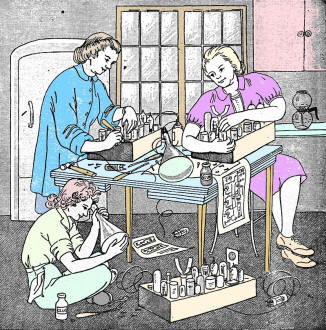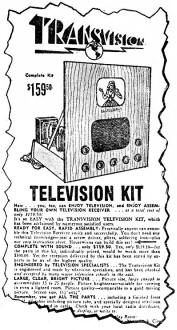Housewives and Television
|
|
Contrary to the scenario presented in this light-hearted mockery of housewives attempting to assemble some electronics kits, there were actually many women during the height of the radio and television age who were quite adept at handling soldering irons and test equipment. In fact, the case could be made that, given the 1947 appearance of this "Housewives and Television" piece in Radio-Craft magazine, women of the post-wartime industrial period were probably the most experienced and adept assemblers of electronics equipment. After all, it was Rosie the Riveter who built airplanes, ships, and tanks while Sally the Solderer built the bulk of the tens of thousands of radios, radars, sonars, medical and test instruments, vacuum tubes, amplifiers, and other electronics while the brothers, sons, and husbands were saving the world from Communism, Socialism, Marxism, Nazism, and all the other ism's threatening to enslave humanity with oppressive governmental control. The stereotype-driven back-and-forth taunting between men and women has always been around - men don't know how to do domestic chores and women don't know anything about cars or electronics. Suck it up and laugh at yourself - you know some of it's true. Housewives and Television "Practically anyone can assemble this receiver," states an advertisement in the New York Times, offering television kits for sale. "Housewives can build this set..." The copywriter probably has in mind the following cozy scene: Three ladies are seated before a workbench in a neat basement. They are assembling television receivers with quiet skill. Mrs. David Sarnou is probably the most efficient worker in the group. She wields a soldering iron with each hand, operating with a power factor of 0.95. Occasionally, a slight fatigue causes her to close her eyes, but she continues working just the same. After a while, Mrs. Sarnou looks up. "Well, girls," she comments with a happy smile, "I've just finished my 7-tube FM section. In fifty minutes more, I should have the 13-tube video circuit completed." "Good for you," says Mrs. Lee de Woods, who is deftly mounting an i.f. can on the chassis of her set. Mrs. de Woods glances rapidly and expertly at her schematic, which is lying on a chair 15 feet away. "Do you know, girls," she remarks, "a casual glance at the diagram inclines me to believe that our video amplifiers are not flat beyond 3 megacycles." "You're wonderful!" says Mrs. Armsweak, wife of Major Armsweak, admiringly. "I could never detect such a flaw if the diagram was more than 10 feet away." In this way, chatting lightly about video topics, the ladies continue their work; and before the morning is over, they have finished assembling, testing, and adjusting their television receivers. In the afternoon, they attend to their shopping, and, after supper, the three women start work on color television sets, which they complete before bedtime. That's the way the copywriter visualizes it.
The scene is the kitchen of Mrs. Susie Hockfleisch. Near Mrs. Hockfleisch are housewives Catherine Tittleberry and Emily Vanderstupe. They are busily assembling television receivers on the kitchen table. "Don't you just love these color-coded wires?" says Mrs. Hockfleisch. "I'm going to tie bow-knots in them, to make them look prettier." "Drat this soldering iron," exclaims Mrs. Vanderstupe. "That's the second time I burned my nose on it." She frowns meditatively. Suddenly a glow lights up face. "I've got it, girls, I've got it!" she cries. The other women look up eagerly. "What is it, Mrs. V.?" asks Mrs. Hockfleisch. "Why should we solder on these wires, when we can just as easily glue them into place?" "What a brain," says Mrs. Tittleberry reverently. Mrs. Hockfleisch nods approval. Vanderstupe's suggestion is immediately carried into action. The irons are discarded, and placed in the refrigerator to cool off. "Vanderstupe's suggestion is immediately carried into action. The irons are discarded. Mrs. Tittleberry fingers an i.f. can. "Does anyone know where this resistor goes?" she asks hesitantly. Mrs. Hockfleisch laughs heartily. "Resistor, indeed!" she cries. "Why, you silly, that's no resistor - that's a condenser l" Helping each other in this way; the women continue their work. Mrs. Hockfleisch wires up her set carefully, making sure there is no clash of colors. Tittleberry carefully attaches the power line cord to the oscillator coil. Vanderstupe has gotten some bread crumbs into the tuning condenser, and is busy prying the plates apart with a can opener to get the particles out. So the time goes pleasantly by. Occasionally the murmur of conversation is drowned out by the shattering of a cathode-ray tube. When the walls have stopped shaking, the women continue where they left off, while tenants in the floors above and below pick pieces of glass out of their eyeteeth. In the evening, the ladies put aside their glue pots, can openers, and other tools. Vanderstupe and Tittleberry depart for their respective homes. Mrs. H. eagerly awaits her husband, Montmorency Hockfleisch, greeting him proudly when he arrives. "You'll never believe it, Montmorency, but I'm building a television set," she exclaims. "Got supper?" asks Mr. Hockfleisch brusquely. He's had a hard day at the office. He's due for a harder night at home. The salad is garnished with cathode-ray tube particles. The beef stew is filled with half-watt resistors. Mrs. H. is overjoyed at finding these missing components. Mr. H., however, scarcely shares her pleasure. His sullen apathy flares into hot anger when he bites into a 10-μf, 450v condenser. "Holy smoke, this is too much!" shouts Hockfleisch. His overburdened mind gives way. Rushing into the living room, where his wife has been playing the phonograph to drown out his anguished cries, he jumps into the automatic record changer while it is changing records, and is never seen again. Television did it, gentle reader . Keep it away from housewives, is our moral.
Posted October 28, 2020 |
|


